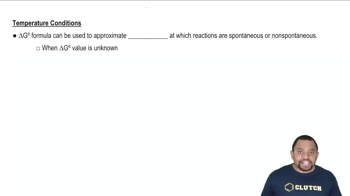Here are the essential concepts you must grasp in order to answer the question correctly.
Standard Free Energy Change (∆G°)
The standard free energy change (∆G°) is a thermodynamic quantity that indicates the spontaneity of a reaction under standard conditions (1 M concentration, 1 atm pressure, and a specified temperature). A negative ∆G° suggests that a reaction is spontaneous, while a positive ∆G° indicates non-spontaneity. It is a crucial factor in predicting whether a reaction will proceed in the forward direction.
Recommended video:
Standard Gibbs Free Energy and Temperature
Equilibrium Constant (K)
The equilibrium constant (K) is a dimensionless value that expresses the ratio of the concentrations of products to reactants at equilibrium for a given reaction at a specific temperature. A K value greater than 1 indicates that products are favored at equilibrium, while a K value less than 1 suggests that reactants are favored. The value of K provides insight into the extent of a reaction's progress towards completion.
Recommended video:
Relationship between ∆G° and K
The relationship between standard free energy change (∆G°) and the equilibrium constant (K) is described by the equation ∆G° = -RT ln(K), where R is the gas constant and T is the temperature in Kelvin. This equation shows that when K > 1, ∆G° is negative, indicating a spontaneous reaction; when K = 1, ∆G° is zero, indicating equilibrium; and when K < 1, ∆G° is positive, indicating non-spontaneity.
Recommended video:
Relationship between ∆E°, ∆G°, and K
 McMurry 8th Edition
McMurry 8th Edition Ch.18 - Thermodynamics: Entropy, Free Energy & Equilibrium
Ch.18 - Thermodynamics: Entropy, Free Energy & Equilibrium Problem 112
Problem 112 Verified step by step guidance
Verified step by step guidance

